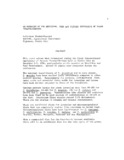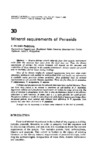An overview of the nutrition, feed and feeding techniques of prawn penaeid/shrimps
- Global styles
- MLA
- Vancouver
- Elsevier - Harvard
- APA
- Help

ดู/เปิด
วันที่
1989ผู้เขียน
Page views
3,846ASFA keyword
AGROVOC keyword
Taxonomic term
เมตาดาต้า
แสดงระเบียนรายการเต็มShare
นามธรรม
This paper echoes what transpired during the first International Conference of Penaeid Prawns/Shrimps held in Iloilo City in December 4-7, 1984, particularly on the Nutrition nd Feed Development. Around 25 papers were presented during the conference.
The nutrient requirements of P. japonicus and to some extent, P. monodon have been studied quite extensively compared to other penaeid species. Requirements for protein, carbohydrates fats, amino acids and essential fatty acids for juveniles and larvae have been defined compared to those of the broodstock.
Optimum protein levels for prawn juveniles vary from 28-38% for P. kerathurus, 40-46% for P. monodon, 43% for P. indicus and 50-54% for P. japonicus. Dissacharides like sucrose and trehalose have been found to be good source of carbohydrates at 20-25% in the diet. Crustacean diets require around 0.5% cholesterol. There are few studies on vitamine and mineral requirements.
There are artificial diets for juveniles and microencapsulated diets that can completely replace live organisms as larval feed. Microencapsulated diets have been field-tested for P. vannamei, P. stylirostris, P. monodon, P. indicus and P. merguiensis in Ecuador, Taiwan, Malaysia, Thailand and the Philippines.
When a commercial diet for the broodstock becomes available ther will be an artificial diet for athe life cycle of tha prawn.
การอ้างอิง
Piedad-Pascual, F. (1989). An overview of the nutrition, feed and feeding techniques of prawn penaeid/shrimps. In R. D. Fortes, L. C. Darvin, & D. L. de Guzman (Eds.), Fish and Crustacean Feeds and Nutrition. Proceedings of the Seminar-Workshop on Fish and Crustacean Feeds and Nutrition, 25-26 February 1985, Iloilo City, Philippines (pp. 4-9). Laguna, Philippines: Philippine Council for Aquatic and Marine Research and Development.
Type
Conference paperคอลเลกชัน
- Conference Proceedings [298]
Related items
Showing items related by title, author, creator and subject.
-
Development of immunological indices for monitoring health status in shrimp (Penaeus monodon)
Amar, Edgar C. ; Catap, Elena S.; de la Peña, Leobert D. (Aquaculture Department, Southeast Asian Fisheries Development Center, 2005-03)
Some hemolymph parameters were determined as non-invasive early-warning indicators of health status in black tiger shrimp (Penaeus monodon). These included total hemocyte count (THC), respiratory burst activity, phenoloxidase ...
; Catap, Elena S.; de la Peña, Leobert D. (Aquaculture Department, Southeast Asian Fisheries Development Center, 2005-03)
Some hemolymph parameters were determined as non-invasive early-warning indicators of health status in black tiger shrimp (Penaeus monodon). These included total hemocyte count (THC), respiratory burst activity, phenoloxidase ... -
Series: Actes de Colloque 9
Mineral requirements of Penaeids
Piedad-Pascual, F. (Institut Francais de Recherche pour l'Exploitation de la Mer, 1990)Marine shrimps absorb minerals from their aquatic environment aside from the minerals that come from the food they eat. Thus, the dietary requirement of shrimps for certain minerals will depend on the amounts and availability ... -
Status of shrimp nutrition and feed development in Southeast Asia.
Piedad-Pascual, Felicitas. (Asian Fisheries Society. AFS Spec. Publ. 4, 1989)World demand for shrimp has increased significantly in the last decade. Of the 32 species investigated, the most commonly cultured in Southeast Asia is the Penaeus monodon . Formulated feed constituted around 50% of the ...




